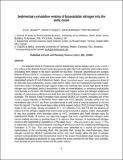Files in this item
Sedimentary exhalative venting of bioavailable nitrogen into the early ocean
Item metadata
| dc.contributor.author | Stüeken, Eva E. | |
| dc.contributor.author | Gregory, Daniel D. | |
| dc.contributor.author | Mukherjee, Indrani | |
| dc.contributor.author | McGoldrick, Peter | |
| dc.date.accessioned | 2022-04-25T23:43:16Z | |
| dc.date.available | 2022-04-25T23:43:16Z | |
| dc.date.issued | 2021-07-01 | |
| dc.identifier | 273979863 | |
| dc.identifier | 2c81cd7a-67a5-4752-a0ca-ab9b9afabd65 | |
| dc.identifier | 85105694445 | |
| dc.identifier | 000649176900015 | |
| dc.identifier.citation | Stüeken , E E , Gregory , D D , Mukherjee , I & McGoldrick , P 2021 , ' Sedimentary exhalative venting of bioavailable nitrogen into the early ocean ' , Earth and Planetary Science Letters , vol. 565 , 116963 . https://doi.org/10.1016/j.epsl.2021.116963 | en |
| dc.identifier.issn | 0012-821X | |
| dc.identifier.other | RIS: urn:EA79ADE77284D38BA7172E8C0501391A | |
| dc.identifier.other | ORCID: /0000-0001-6861-2490/work/93161606 | |
| dc.identifier.uri | https://hdl.handle.net/10023/25246 | |
| dc.description | EES acknowledges financial support from the School of Earth & Environmental Sciences, St Andrews. DDG acknowledges the support of NSERC for his Discovery grant (grant number 04834). | en |
| dc.description.abstract | Ore deposits found in Proterozoic marine sedimentary basins supply much of the world's zinc. Many of the deposits formed contemporaneously with their host sediments when saline brines circulating from deeper in the basin reached the sea floor. Textural, geochemical and isotopic features of these SEDEX (‘sedimentary-exhalative’) deposits and their host sediments indicate that biologically active seeps, vents and brine pools were a feature of many ore-forming systems. In mineralised pockets of mid-Proterozoic basins, these ‘microbial oases’ were productive areas in an otherwise low productivity, anoxic, deep marine realm. Here we hypothesize that these metal-rich brines which circulated through organic matter-rich substrate also carried high levels of fixed nitrogen and stimulated distinct ecosystems at sites of mineralisation, or enhanced productivity more broadly in the basin. We tested this hypothesis with organic carbon and nitrogen analyses of samples of carbonaceous siltstone and shale from the 1.64 Ga Barney Creek Formation of northern Australia. The Barney Creek Formation hosts several SEDEX Zn systems, including one of the world's largest deposits at McArthur River Mine (the HYC deposit). Samples come from the mineralised edge of HYC and from correlated strata in drill cores at varying distances (1-60 km) from the deposit. The data reveal lower ratios of total organic carbon (TOC) to total nitrogen (TN) closer to the ore body. Strong correlations (r2>0.7) between TOC and TN and the absence of excess N in the samples suggest that most N was buried as bound to organic matter. Bioavailable N was thus probably more abundant closer to HYC, consistent with fixed nitrogen input by hydrothermal fluids. If correct, our data may suggest that such a hydrothermal nitrogen point source enabled microbes to develop lower C:N ratios in their biomass. A hydrothermal nitrogen source is also supported by a gradient in δ15N values from = +4‰ proximal to the vent to +7.5‰ in distal sites, which may point towards recycling of ammonium from the underlying Wollogorang Formation (1.73 Ga). This unit has previously been identified as a source of over-mature hydrocarbons to the ore-forming fluid. We speculate that, during the mid-Proterozoic, fixed nitrogen carried by SEDEX hydrothermal brines may have locally offset the lack of aerobic nutrient remineralization that characterized most of the anoxic Precambrian deep ocean and thus stimulated biological productivity in areas where the brines reached the sea floor, and, possibly, more broadly as spent brines mixed into the water column. | |
| dc.format.extent | 1352796 | |
| dc.language.iso | eng | |
| dc.relation.ispartof | Earth and Planetary Science Letters | en |
| dc.subject | Proterozoic life | en |
| dc.subject | Nitrogen cycling | en |
| dc.subject | SEDEX deposits | en |
| dc.subject | G Geography (General) | en |
| dc.subject | NDAS | en |
| dc.subject | SDG 14 - Life Below Water | en |
| dc.subject | AC | en |
| dc.subject.lcc | G1 | en |
| dc.title | Sedimentary exhalative venting of bioavailable nitrogen into the early ocean | en |
| dc.type | Journal article | en |
| dc.contributor.institution | University of St Andrews. School of Earth & Environmental Sciences | en |
| dc.contributor.institution | University of St Andrews. St Andrews Centre for Exoplanet Science | en |
| dc.identifier.doi | https://doi.org/10.1016/j.epsl.2021.116963 | |
| dc.description.status | Peer reviewed | en |
| dc.date.embargoedUntil | 2022-04-26 |
This item appears in the following Collection(s)
Items in the St Andrews Research Repository are protected by copyright, with all rights reserved, unless otherwise indicated.

